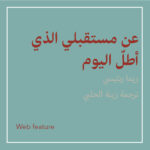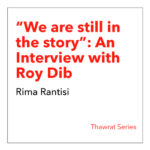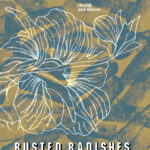It may seem obvious that I write an editorial note about editorial labor in an issue on labor. That’s fine. But I’m going to do more than that – so that I don’t bore you (I don’t mind this kind of labor). I am not going to focus on issue 11 in this note. You can do that work. In other words, no interpreting for you, fitting each piece into lyrical one-sentence summary-analyses (ie. “Emerging writer, Mohamad Tarhini, writes a lilting lyric essay linking the death of his grandfather, a tobacco farmer, to the seasons of tobacco farming.”), no framing or connecting or synthesizing or telling you the literary or artistic significance of the gems we have in this issue (see: Marilyn Hacker’s crown of sonnets, Tamara Saade’s emulsion lifts, Reem Aljeally’s “Questions to Siri” painting series). I mostly want to tell you about editorial labor.
With every editorial since 2012, I do the painstaking work of pulling out the salient themes of the pieces to share them with you here (I always write them last minute and do not enjoy it) to entice you and give proper attention to our contributors, who deserve everything, surely, and more. (You taught me so much in these pages, you always do.) As a writer, I feel that a life without literary friends is no life at all. With whom better to discuss the minute agonies, technicalities, and idiosyncrasies of writing and life than another writer? But in what ways does the editor befriend the writer? As an editor, I am personally invested and, as I see it, even part of the work I edit, like a florist and her bouquets, chopping stems, placing each one at an angle, giving it a new life. From first picking the bouquet, to pruning and sprucing and talking to it to putting it into a vase, it’s thankless work, unglamorous to say the least – the bouquet, the writers, get all the attention. They should. But there’s this bond that transpires between editor and writer that surpasses the glam: I suddenly have a new writer friend. We don’t have to be close – we may never speak again after the piece launches into the world – but we’ve been intimate, even if fleetingly, in this editor-writer fling.
The pieces that grapple with “care work” in this issue (Maude, Reumert, Kahil) got me thinking about editing as care work, key in the intimate space that writer and editor hold in their brief relationship. This is an approach, of course. And literary editing is hardly paid enough (if paid) to care. That is, to care about a (fellow) writer’s work (and feelings); to care for the material as if it’s your own; to care to bring the work to the next level, to push through ideas with a writer, to spend hours and drafts in mastering a piece both on a literary and technical level for public consumption, for the archives. I ask myself often why I care about editing and publishing. There is a compulsion to this work that is at times incomprehensible coupled with the chemical rush of a literary crush.
I will be honest: There’s power in bringing others’ work to light. In addition to critique, selection is inherent to editorial work. As a Gen X’er from a small American town, I grew up as an adolescent reading primarily white men and women while not having the language or understanding of what it meant to read only white writers. I loved Beverly Cleary and the Fear Street series and anything my teachers put into my hands: The Hobbit, Where the Red Fern Grows, The Great Gatsby. You know, the great white list. I loved reading, so these books were easy to love. University courses expanded representation of people of color in literature slightly, but Arab voices never featured in them. I am aware that “representation” is a sticky concept (the play, “almost equal to,” by Jonas Hassen Khemiri, in this issue tells you plenty about that). It can never be complete, and I will have my biases and shortcomings when featuring Arab or Arab-adjacent writers in this journal. But that’s why we have a team, and that’s why editorial work should be challenged and praised and discussed as a driver of intellectual and artistic knowledge. Publishing and caring for voices beyond the hegemony of white writing means working toward preservation, presence, and power of others’ work. This is our part in the editorial politics in the region: the reciprocity (that care entails) that is needed to create community through labor.
The contributors in these pages are from Palestine, Yerevan, Khartoum, Tripoli (Libya), Paris, Berlin, Sweden, and cities across Lebanon and the US. At the time of this writing, our grief looms large as in the past three months, we have witnessed two genocidal armies attempt to wipe out the populations of the Republic of Artsakh (Nagorno-Karabakh) and Palestine. While finalizing this issue, we published a piece titled “Can the Palestinian Mourn?” by Abdaljawad Omar in our webzine. He asks: “How can one grieve within a space of relentless revulsion that erects barriers, redefines boundaries, desecrates bodies, and takes lives arbitrarily?” His answer is that Palestinians can’t properly grieve, and won’t, until there is justice. In this issue, Justin Salhani’s essay about the labor of grieving the death of his father makes Omar’s words even more haunting when he writes, “I’m afraid that if I don’t work through my grief, it will leave a human part of me behind.”
In editing, as in art, it is toward these transtextual conversations and close-up views into the darkness and the light, into the frailty and the fortitude of the human condition, that we work.

Rima Rantisi
Rima Rantisi teaches in the Department of English at the American University of Beirut and is the founding editor of Rusted Radishes: Beirut Literary and Art Journal. Her essays can be found in theNew England Review, Literary Hub, Assay: A Journal of Nonfiction Studies, Sweet: A Literary Confection, Past Ten, and Slag Glass City. She holds an MFA in Creative Nonfiction from the Vermont College of Fine Arts.







